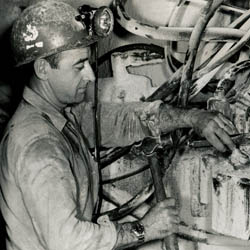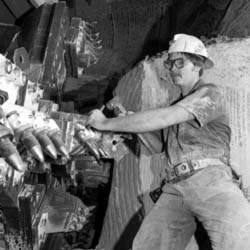'We have a saying in the industry... "if it can't be grown it was probably mined."'
The mining industry is vitally important to Saskatchewan both for its contributions to employment and to government revenue. It is the province's third largest industry. In 2008 Saskatchewan mining companies made the province Canada's #1 mineral producing jurisdiction, accounting for 21.5% of Canada's total mineral output with production valued at a record $9.7 billion dollars.['1']
According to the Saskatchewan Mining Association, the industry currently provides direct and indirect employment to over 25,000 people. These jobs include prospecting, surveying, engineering, environment management, human resources, legal and land contract management, accounting, IT, marketing, management and office administration, site operations, safety regulation, skilled trades, and heavy equipment operators. The current average weekly salary of a mining industry employee is almost double that of the average weekly salary of employees in other sectors.
Mining is often viewed as a dangerous occupation, because of its less regulated early history and in part because mine accidents and injuries are widely publicized. Improved technology and increased regulation, involving the present employment of over 100 safety professionals, have contributed to an improved safety record relative to other industries.
Aboriginal people in northern Saskatchewan have long been involved in mineral exploration and prospecting. Their involvement with mining companies is now much more extensive and the industry boasts that it is one of the leading employers of aboriginal people. In 2007 northern mine sites employed 1,317 people from northern Saskatchewan; 1,125 of these employees were of aboriginal ancestry.['2']
Saskatchewan prospectors have uncovered a wealth of mineral resources. Presently provincial mines extract potash, uranium, coal, gold, salt, meta-kaolin, silica sand, sodium sulphate, clay and bentonite. The discoveries of kimberlite (a rock which sometimes contains diamonds) at Sturgeon Lake and Fort a la Corne in the 1980s have raised hopes that northern Saskatchewan may have potential for commercial diamond production.
Saskatchewan's mining history dates back to the late 19th century when large deposits of lignite coal were discovered and exploited in the Estevan area. Initially most of the mines were small and the work hard and dangerous. During the earliest period much of the coal produced was used to satisfy the demand for fuel in treeless southern Saskatchewan. Large quantities of coal are still strip-mined and used in the generation of electric power at Estevan and Coronach.
The province's massive potash deposits were first discovered in 1942 during exploration for petroleum near Radville. Potash production in Saskatchewan has been continuous since 1962, when IMC Global opened the K-1 mine at Esterhazy.
The first northern Saskatchewan uranium deposits were discovered in the 1930s. The Athabasca Basin of Saskatchewan has been the site of all major Canadian uranium discoveries in the past 40 years. After World War II a federal ban on the private exploration of the mineral was lifted, sparking a prospecting and staking rush in the area.
The Eldorado Mining and Refining Company operated the Beaverlodge uranium mine near Uranium City from 1953 to 1982. The town thrived along with the uranium boom and at its height had a population approaching 5,000. When the mine closed in 1982 the local economy collapsed and most of the population moved away.
Footnotes
↑ ['1'] Saskatchewan Mining Association. General Information. Mineral Production. Accessed April 16, 2010.
↑ ['2'] Saskatchewan Mining Association. General Information. Careers. Accessed April 16, 2010.


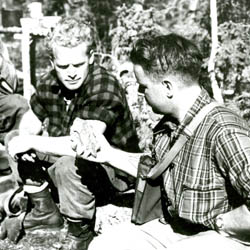
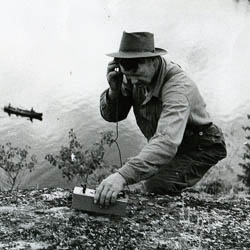
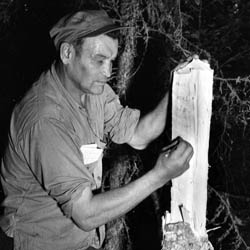
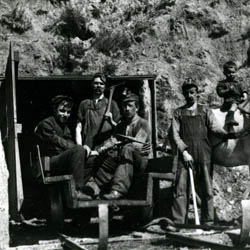
![Loading Coal, ['ca. 1910s']](cropthumbs/R-A937.jpg)
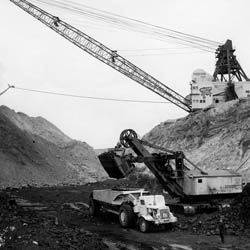
![Coal Mining - Shovel, ['ca. 1930?']](cropthumbs/R-A8487.jpg)
![Claybank Brick Plant, ['ca. 1910s']](cropthumbs/R-A28465-1.jpg)
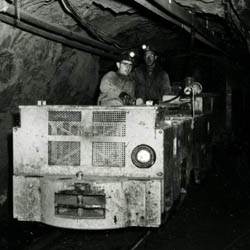
![Miners Coming Off Their Shift, Eldorado Mine, ['195-?']](cropthumbs/SD-7-f8-106.jpg)
